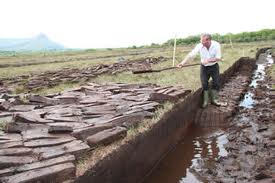Everyone is busy during these long light evenings turning their turf to allow it to dry out...
Very few people cut by hand anymore...it's back-breaking work just turning, never mind using the short double handled broad blade known as a slan to cut each segment and then toss it to one side to be laid out neatly later on...now it's cut by huge machines...rather like combine harvesters...they cut the turf out in long strips which lie side by side waiting for a family to come and begin the long process of saving it for fuel for the winter.
Some of the older men build themselves a little bothy out of willows and roof it with a bit of old tin...an old wooden chair with the legs shortened and a primus stove for the tea...they can retreat there when the biting midges come down in clouds or when it pours with rain...smoke a rollie and have a read of the Sun newspaper.
Entire families would go out to the bog not so long ago...bringing bottles of cold tea and cooked potatoes in their skins for a bit of lunch...
Down the Island road, going towards Boyle, we pass small plots of turf still cut from the banks by hand...two elderly men working on their own out by the lake side...they build neat stacks of the dried turf...all the ends pointing outwards so the rain runs off and doesn't make them wet...then they tie lengths of rope with hefty stones at each end to throw over the stack to keep it safe from the winds...
I once read a newspaper article which stated firmly that no-one in Ireland ever saves their turf this way anymore...that it was in the past. Perhaps I should have written in reply and told them the old ways are alive and well here.
Turf isn't the remains of ancient woodland in the way that coal is...it's the rotted remains of grasses and herbage...small shrubs like Bog Myrtle...it's dense and heavy when first cut...almost black in colour, then as it dries the colour fades to dark brown and it's light and easy enough to handle.
Every cottage would have had a turf shed...many still do. There is a matter of pride in how it's stacked in the shed...in perfectly straight lines with each outer piece sticking out slightly...you should always use last year's turf first. Turf sheds are never enclosed...the front is always open to the weather...partly for convenience and partly to allow the air to the stack which keeps it dry.
The donkey was used to pull the cart full of turf home...over and over again they'd make their way down narrow laneways and across bogs...it's said that some donkeys knew the routine so well they could be entrusted to bring the cart home unaccompanied...one of the family would unload it and send the donkey back to the bog for another load.
For those cottagers who were too poor to own a donkey there was no other alternative than to carry the turf back in panniers across their shoulders...it must have taken an age to bring it all home.
Sometimes people digging their turf or the man driving the big unwieldy machine will see something worth stopping for...bones perhaps...scraps of cloth or a brief glimpse of something metal. Gold torcs...the elaborate neck pieces worn many thousands of years ago...the tattered remains of an ancient cloak or a pair of Mediaeval shoes with pointy shoes. Maybe a bog body...one of those enigmatic remains which are found from time to time. Sacrificial victims to unknown gods...fed on honey and sweet cakes...garrotted and placed where they've laid undisturbed for a thousand years and more.
Now they lie in the Museum...hair wound up in a neat top-knot...carefully manicured hands showing they were men of some status in their society...an arm band...braided from thin strips of leather, much the same as the wristbands worn today by young men.
One day the bogs will be 'cut out' there'll be no more useable turf to be had...it'll take many thousands of years for more layers of rotted vegetation to be laid down. In the meantime the cut out bogs are home to the Irish Hare and the Hen Harriers...home to the wild duck who swim and nest in the watercourses criss-crossing the land...there are tiny bog plants. Sundews and rare Orchids...a mass of Bog -Cotton in the height of summer...wild Marjoram and Valerian...Heathers and Lings...sweet wild Raspberries and patches of Whinberries. And still secrets waiting to be revealed.

